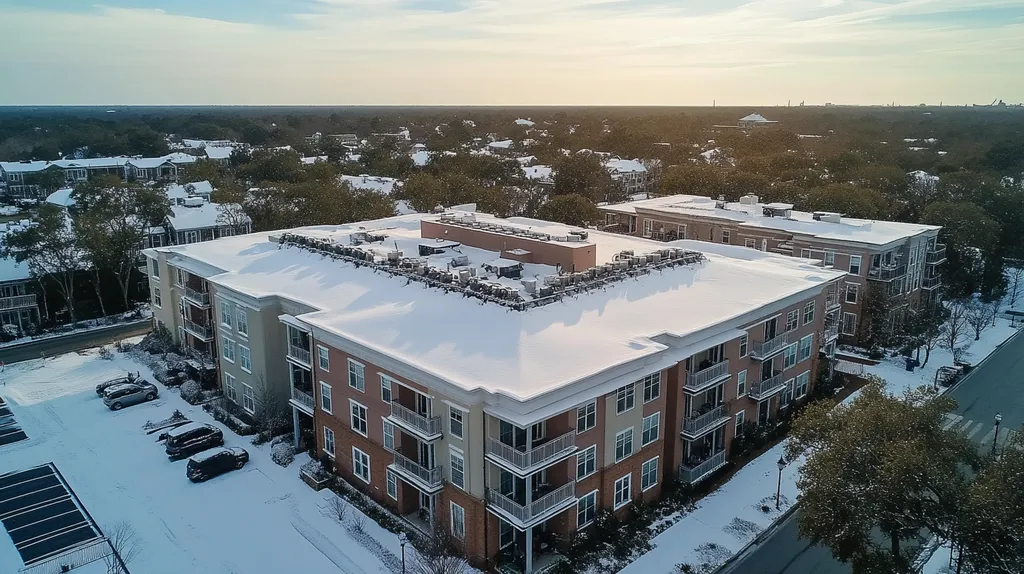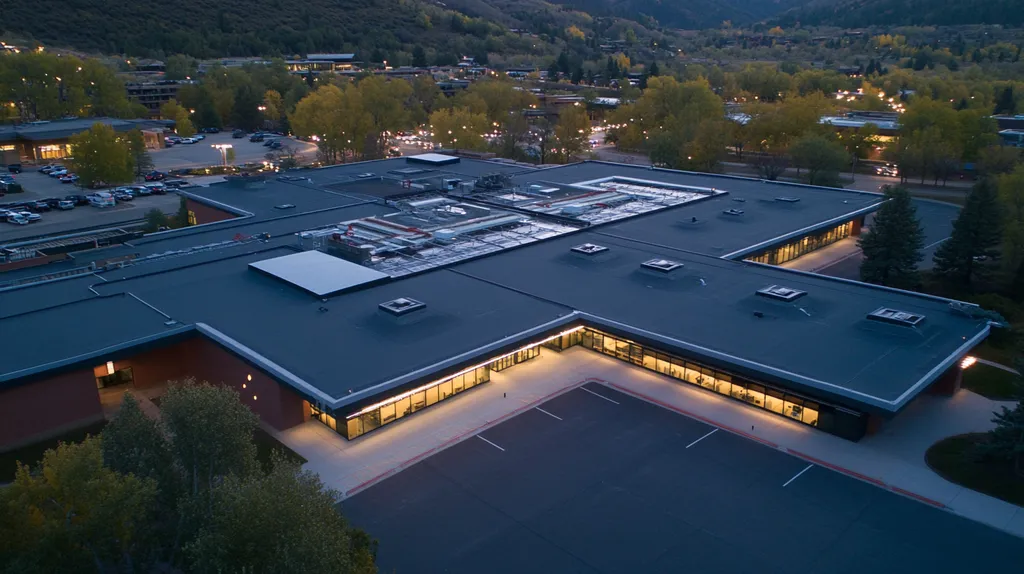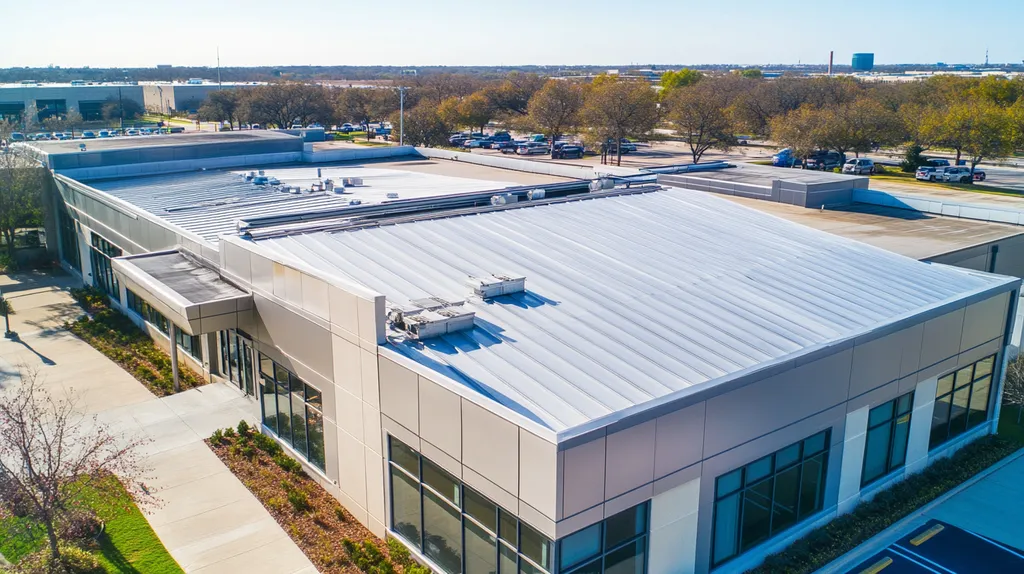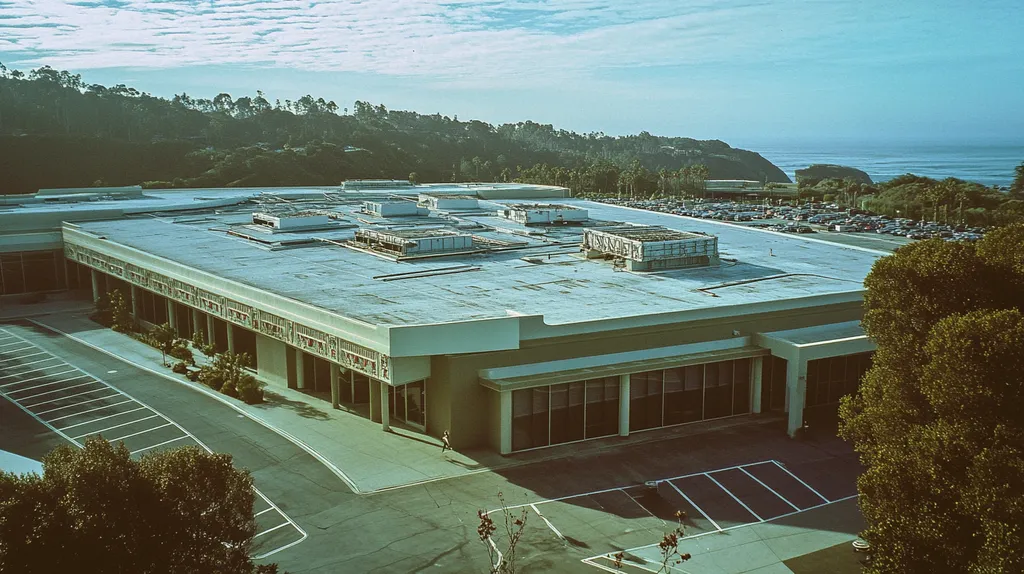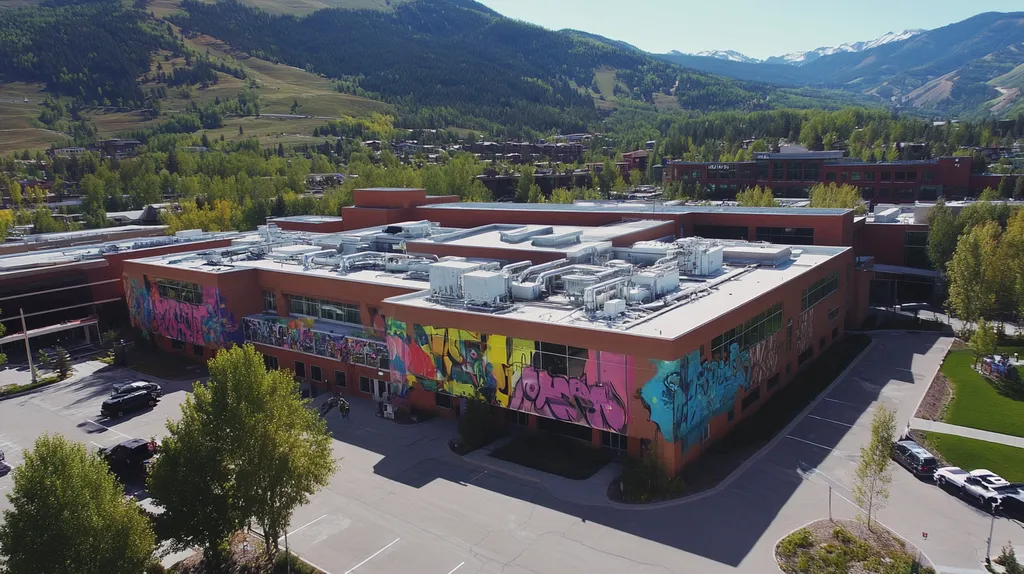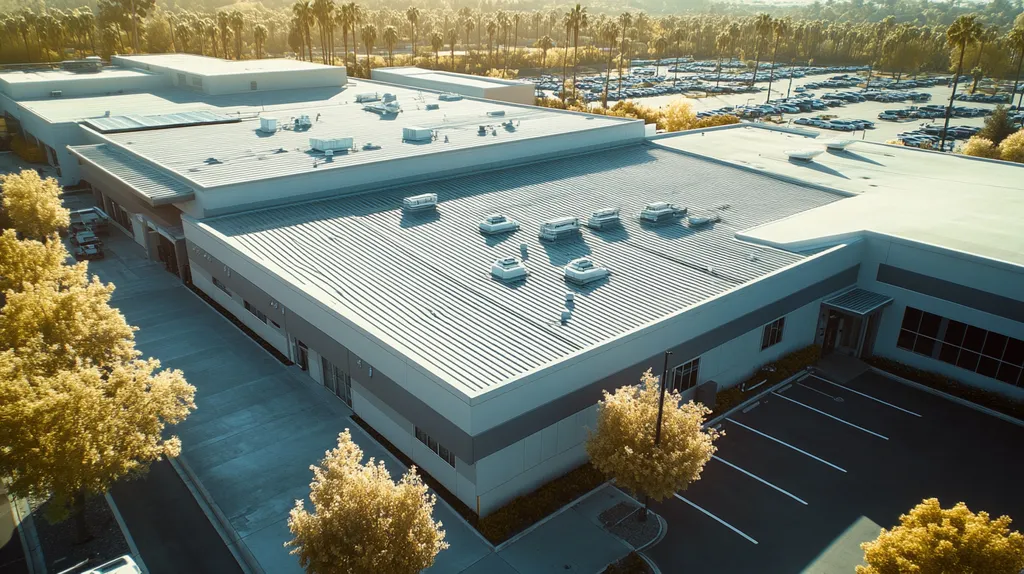Commercial roof failures cost U.S. businesses over $2.5 billion annually, yet industry data shows that 85% of these catastrophic incidents stem from preventable maintenance oversights.
Despite these staggering numbers, persistent myths about roof maintenance continue driving decisions that threaten building operations and accelerate system deterioration.
This analysis examines common misconceptions about commercial roof care, their costly implications, and evidence-based maintenance strategies that can double or triple roof lifespan while preventing emergency repairs.
SECTION 1: COMMON MISCONCEPTIONS
The financial stakes of commercial roof maintenance are staggering, with premature failures often costing building owners hundreds of thousands in repairs and business disruption. While most owners understand their roof’s importance, persistent myths continue to drive poor maintenance decisions. These misconceptions not only threaten the integrity of roofing systems but also put entire buildings at risk.
Myth: Routine Roof Maintenance Is Optional
Building owners often view roof maintenance as a discretionary expense rather than a critical investment. This mindset typically stems from the roof’s “out of sight, out of mind” nature and the desire to minimize operational costs.
The reality is that skipping routine maintenance accelerates deterioration exponentially. Even minor issues like clogged drains or small punctures can quickly escalate into major structural problems when left unchecked.
Most manufacturer warranties require documented maintenance to remain valid. Without proper maintenance records, owners risk voiding these valuable protections, leaving them fully exposed to costly repairs.
The most effective maintenance programs combine scheduled inspections with prompt repairs, creating a proactive approach that extends roof life while reducing total ownership costs.
Misunderstanding Roof Lifespan and Material Differences
Many owners mistakenly believe all commercial roofing systems have similar lifespans and maintenance requirements. This oversimplification leads to inappropriate care schedules that can dramatically shorten a roof’s service life.
Built-up roofing (BUR) systems typically last 20-30 years but require frequent inspection of their multiple layers. Single-ply membranes might last 15-25 years but need careful monitoring of seams and flashings.
Climate and building use significantly impact maintenance needs. Roofs in areas with extreme weather require more frequent inspections, while those supporting heavy HVAC equipment need specialized attention around mounting points.
Understanding these variables allows owners to develop targeted maintenance strategies that maximize their specific roofing system’s performance and longevity.
Myth: Lack of Leaks Means Roof Is Problem-Free
The absence of visible leaks often creates a false sense of security among building owners. This dangerous assumption ignores the fact that most serious roof problems develop long before water enters the building.
Modern roofing systems are designed with multiple layers of protection. Water can penetrate outer layers and cause extensive damage while interior spaces remain dry, masking developing problems.
Infrared scanning and moisture testing often reveal significant hidden issues in roofs that appear leak-free. These problems, if left unaddressed, typically lead to sudden, catastrophic failures.
Regular professional inspections using advanced diagnostic tools remain the only reliable way to assess a roof’s true condition. Visual inspections alone cannot detect many early-stage problems that threaten roof integrity.
SECTION 2: PRACTICAL IMPLICATIONS
Commercial roof failures cost U.S. businesses over $2.5 billion annually in repairs, inventory damage, and lost productivity. Despite these staggering numbers, many property owners continue to underestimate maintenance requirements. Recent industry data shows that 85% of premature roof failures stem from inadequate maintenance practices, highlighting the critical need for proactive care strategies.
Impact of Neglected Maintenance on Roof Performance
Leaks visible inside buildings often indicate extensive hidden damage has already occurred. Professional inspections regularly uncover severe deterioration in seemingly functional roofs, with repair costs typically 4-5 times higher than preventive maintenance. (source: SmartSeal Roof Maintenance)
Membrane deterioration accelerates exponentially when minor damage goes unaddressed. What begins as a small puncture can quickly compromise surrounding materials, leading to widespread system failure within months.
Drainage issues from neglected maintenance create dangerous structural loads. Just one inch of standing water adds five pounds per square foot of weight, potentially exceeding design limits during heavy rain.
UV damage and thermal cycling cause rapid material breakdown without proper upkeep. Regular maintenance can double or triple a roof’s effective lifespan by addressing these environmental stressors before they cause permanent damage.
Consequences of Incorrect Repair and Material Choices
Using incompatible materials or improper repair techniques often creates more problems than they solve. Mixing different membrane types or using generic sealants can accelerate deterioration and void manufacturer warranties.
Poor flashing repairs account for nearly 60% of premature roof failures. Incorrect installation methods create weak points where water can penetrate multiple layers, leading to widespread damage before detection.
DIY repairs or unlicensed contractors frequently compromise roof integrity. Their work often fails to meet code requirements and manufacturer specifications, creating liability issues and increased replacement costs.
Improper repairs around rooftop equipment create particularly vulnerable areas. HVAC units, vents, and other penetrations require specialized knowledge and materials to maintain watertight conditions.
Tenant Disruption Myths During Maintenance and Replacement
Modern maintenance techniques minimize tenant impact through careful scheduling and efficient workflows. Most preventive maintenance can be completed during off-hours with minimal noise or disruption.
Strategic planning allows major repairs to be completed in phases. This approach maintains building operations while addressing critical areas first, followed by less urgent repairs during convenient times.
Advanced notification systems keep tenants informed about maintenance schedules. Clear communication about work scope and timing helps prevent complaints and maintains positive relationships.
Technology innovations have dramatically reduced maintenance disruptions. Infrared scanning, drone inspections, and non-invasive moisture testing allow thorough evaluations without disturbing building occupants.
SECTION 3: COST OF MISINFORMATION
The financial impact of roofing misinformation extends far beyond immediate repair costs. Industry data shows that poorly maintained commercial roofs typically last only 10-12 years instead of their designed 20-30 year lifespan. This premature failure creates a cascade of expenses, from emergency repairs to business interruption costs that can exceed $100,000 per incident.
Financial Risks of Delaying Roof Inspections and Repairs
Just because your roof isn’t actively leaking doesn’t mean it’s in good condition. Waiting for visible signs of failure means you’re already too late, as routine inspections can identify potential issues long before they turn into costly leaks or structural damage. (source: SmartSeal)
Structural deterioration accelerates exponentially when left unchecked. What begins as a $500 repair can balloon into a $50,000 emergency replacement within months of neglect.
Building insurance carriers increasingly scrutinize maintenance records when processing claims. Properties without documented inspection histories often face claim denials or reduced coverage.
Energy costs spike dramatically when roof systems begin to fail. Compromised insulation and thermal barriers can increase HVAC expenses by 25-35% annually.
Expense Comparison: Preventive Maintenance vs. Emergency Repairs
Preventive maintenance programs typically cost $0.10-$0.15 per square foot annually. Emergency repairs, by contrast, average $5-$7 per square foot, representing a 50-fold increase in expense.
Labor costs for emergency repairs run 300-400% higher than scheduled maintenance. After-hours service calls and expedited material delivery create significant price premiums.
Water damage from delayed repairs compounds expenses exponentially. A single roof leak can damage inventory, equipment, and interior finishes worth hundreds of thousands.
Business interruption costs often dwarf direct repair expenses. Revenue losses from facility closures typically range from $5,000-$25,000 per day, depending on building use.
Hidden Costs from Improper DIY or Contractor Selection
DIY repairs frequently void manufacturer warranties, eliminating valuable coverage that could save thousands in future repairs. Most warranties require professional installation and maintenance.
Unqualified contractors often create more problems than they solve. Their work commonly fails within 12-18 months, requiring complete replacement rather than simple repairs.
Material compatibility issues plague amateur repairs. Using incorrect sealants or patching materials can accelerate deterioration of surrounding roofing components.
Code compliance violations from improper repairs create liability exposure. Building owners face potential fines and increased insurance costs when repairs fail to meet local requirements.
SECTION 4: REALITY CHECK
Commercial roofing failures cost U.S. businesses billions annually in repairs, lost productivity, and damaged inventory. Yet many building owners continue operating with a dangerous “fix it when it breaks” mentality. Industry data shows that 85% of catastrophic roof failures begin as minor issues that proper expertise could have identified and corrected early. Understanding the critical role of specialized knowledge, recognizing warning signs, and maintaining consistent inspections can prevent most major roofing disasters.
Importance of Specialized Commercial Roofing Expertise
Commercial roofing systems require specialized knowledge far beyond residential experience. These complex assemblies involve multiple layers, sophisticated drainage systems, and critical interface points with building mechanical systems.
Material compatibility presents a particular challenge unique to commercial applications. Different membrane types, sealants, and flashing materials must work together seamlessly across large surface areas under extreme conditions.
Local building codes and insurance requirements add another layer of complexity. Specialized commercial contractors understand these requirements and ensure all work maintains building code compliance and warranty validity.
Energy efficiency considerations demand expert analysis of insulation, reflectivity, and thermal bridging. Only specialists can properly evaluate how roofing choices impact overall building performance and operating costs.
Early Warning Signs That Require Timely Attention
Interior signs often indicate serious exterior problems. Stained ceiling tiles, unusual odors, or increased humidity levels suggest water infiltration that requires immediate investigation.
Surface blistering, wrinkles, or separation at seams indicate membrane stress that will lead to failure. These seemingly minor issues can quickly escalate into major leaks if left unaddressed.
Ponding water lasting more than 48 hours after rainfall signals drainage problems. This excessive weight stresses the roof structure while accelerating material deterioration.
Flashing deterioration around penetrations, edges, and transitions demands prompt attention. These critical junctions are common failure points that can compromise large sections of roofing when neglected.
Necessity of Regular Inspections Beyond Visible Damage
Modern inspection techniques reveal problems invisible to the naked eye. Infrared scanning detects trapped moisture while core sampling analyzes subsurface conditions that threaten roof integrity.
Seasonal changes create unique stress patterns requiring specialized evaluation. Temperature fluctuations, UV exposure, and precipitation cycles affect different roofing systems in distinct ways that only regular monitoring can track.
Documentation from systematic inspections provides crucial trending data. This information helps predict potential failures and optimize maintenance timing to prevent emergency repairs.
Professional evaluations extend beyond surface conditions to examine structural components. Regular assessment of deck deflection, drainage capacity, and mechanical attachment prevents catastrophic failures.
SECTION 5: EVIDENCE-BASED ALTERNATIVES
Commercial roof failures cost property owners millions annually in emergency repairs and business disruption. Yet research shows that 85% of these failures are preventable through evidence-based maintenance strategies. The key lies in moving beyond reactive approaches to embrace systematic inspection protocols, climate-appropriate materials, and professional maintenance programs that dramatically extend roof performance.
Implementing Scheduled Biannual Roof Inspections
Think of roof maintenance like an oil change for your car – a small investment that prevents much bigger, much more expensive problems down the road. Regular inspections and protective coatings can extend roof life by decades while preventing emergency repairs and costly leaks. (source: SmartSeal)
Spring and fall inspections allow technicians to assess winter damage and prepare for severe weather seasons. These critical checkpoints identify developing issues before they compromise the roofing system’s integrity.
Professional inspections must include comprehensive documentation of findings, photos of problem areas, and detailed recommendations. This documentation creates a valuable historical record for tracking deterioration patterns and planning repairs.
Modern inspection technologies like infrared scanning and moisture mapping detect hidden problems invisible to the naked eye. These advanced diagnostics prevent catastrophic failures by identifying subsurface issues before they manifest as leaks.
Selecting Roofing Materials Based on Climate and Use
Material selection must account for both local weather patterns and building-specific stressors. High-traffic roofs need enhanced puncture resistance, while facilities with heavy equipment require reinforced load-bearing capacity.
UV exposure, temperature extremes, and precipitation patterns determine optimal membrane choices. TPO excels in hot climates due to superior heat reflection, while EPDM better handles freeze-thaw cycles in colder regions.
Chemical exposure from building exhaust systems demands specialized material considerations. Facilities with commercial kitchens or industrial processes need enhanced chemical resistance to prevent premature deterioration.
Wind uplift requirements vary by building height and location. Coastal properties need stronger attachment systems and enhanced edge details compared to inland structures.
Professional Maintenance Plans That Extend Roof Lifespan
Structured maintenance programs deliver measurable life-extension benefits through systematic care. These programs typically include quarterly inspections, preventive repairs, and detailed condition reporting.
Professional plans ensure proper cleaning of drains, removal of debris, and maintenance of flashings. These routine tasks prevent the cascading damage that occurs when minor issues go unchecked.
Maintenance contracts often include emergency response provisions for severe weather events. This guaranteed service prevents extended exposure to damaging conditions during nights and weekends.
Most programs incorporate budget forecasting for predictable expense management. This approach allows property owners to plan for necessary repairs rather than facing unexpected emergency costs.
SECTION 6: TEST AND VERIFY
Commercial roof failures cost businesses millions annually in repairs, inventory damage, and operational disruptions. While many property owners understand the importance of maintenance, few implement systematic testing and verification protocols. Without rigorous assessment methods, even well-maintained roofs can develop hidden problems that escalate into catastrophic failures. Understanding and implementing proper testing procedures is crucial for protecting these valuable assets.
Methods for Thorough Roof Condition Assessment
Regular inspections must follow a systematic approach to effectively identify potential issues. Professional assessments should examine membrane condition, seam integrity, and drainage patterns across the entire roof surface.
Moisture detection requires specialized equipment including infrared cameras and electronic leak detection systems. These tools can identify water infiltration long before visible damage appears inside the building.
Core sampling provides critical data about insulation condition and membrane attachment. Strategic sampling locations help evaluate overall system performance while minimizing penetrations through the roof membrane.
Regular inspections and proper maintenance from qualified professionals can dramatically extend roof life while minimizing repair costs. If you want optimal roof performance at the lowest cost, invest in biannual inspections and address maintenance issues promptly. (source: Hoyt Exteriors)
Verifying Contractor Credentials and Maintenance Procedures
Contractor selection requires thorough verification of licenses, insurance coverage, and manufacturer certifications. These credentials ensure technicians have proper training for specific roofing systems.
Documentation practices reveal contractor professionalism and attention to detail. Quality contractors maintain detailed records of inspections, repairs, and material applications.
References from similar commercial properties provide valuable insights into contractor performance. Speaking with other facility managers helps evaluate response times and work quality.
Written maintenance agreements should clearly define inspection schedules, repair protocols, and emergency response procedures. These contracts protect both parties while ensuring consistent service delivery.
Using Technology to Monitor Roof Health and Detect Issues Early
Advanced monitoring systems now provide real-time data on roof performance. Integrated sensors track moisture levels, membrane movement, and structural loads to identify developing problems.
Drone technology enables comprehensive visual inspections without putting workers at risk. High-resolution imaging helps document roof conditions while reducing inspection time and costs.
Predictive analytics software processes inspection data to forecast maintenance needs. These tools analyze performance trends and environmental factors to optimize repair timing.
Digital documentation systems create searchable records of all roof-related activities. This information helps track deterioration patterns and validate warranty claims when needed.
The Bottom Line
Commercial roof failures cost U.S. businesses over $2.5 billion annually, yet 85% of these catastrophic incidents are preventable through proper maintenance.
The evidence is clear: neglecting regular inspections transforms minor $500 repairs into $50,000 emergency replacements, while proper maintenance programs can double or triple roof lifespan.
Modern diagnostic tools, from infrared scanning to moisture mapping, now make it possible to detect and address problems long before they escalate into costly failures.
Building owners who implement systematic biannual inspections, select climate-appropriate materials, and maintain detailed documentation consistently achieve 20-30 year roof lifespans while avoiding emergency repairs that threaten business continuity.
FREQUENTLY ASKED QUESTIONS
Q. Is maintenance for a commercial roof optional?
A. No, routine maintenance is critical for extending the roof’s lifespan. Owners who consider it optional risk premature failures, which can lead to costly repairs. Proactive maintenance helps identify minor issues before they escalate into major problems.
Q. What happens if I neglect my industrial roof maintenance?
A. Neglected maintenance can lead to severe structural damage and leaks that may compromise building safety. Repair costs can increase exponentially, proving far more costly than regular upkeep. Additionally, business disruptions from unexpected failures can lead to significant revenue losses.
Q. How often should I inspect my commercial roof?
A. It’s recommended to schedule biannual inspections, ideally in spring and fall. These inspections help assess seasonal damage and prepare for adverse weather. Regular assessments ensure minor issues are identified before they escalate to significant problems.
Q. Does my commercial roof require specialized knowledge for maintenance?
A. Yes, commercial roofing systems are complex and require specialized knowledge for effective maintenance. Professionals understand material compatibility, local codes, and the intricacies of drainage systems. Their expertise ensures that repairs and maintenance meet warranty requirements and prolong roof life.
Q. How can misinformation affect my industrial roof maintenance?
A. Misinformation can lead to improper maintenance practices and premature roof failures. Believing myths can cause owners to overlook necessary inspections or repairs, which ultimately results in higher costs and reduced roof lifespan. Knowledgeable decision-making is essential for effective care.
Q. Are there methods for monitoring my commercial roof’s condition?
A. Yes, using advanced monitoring systems, such as sensors and drones, can provide real-time data about the roof’s condition. These technologies can detect moisture levels and structural stresses, allowing for early intervention before significant damage occurs.
Q. What are best practices for roof maintenance plans?
A. Effective maintenance plans include scheduled inspections, preventive repairs, and thorough documentation of findings. Utilizing qualified contractors ensures compliance with manufacturer specifications. Regular maintenance helps mitigate future repair costs and prolongs the roof’s lifespan significantly.

